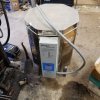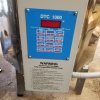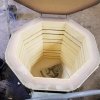You will get a continuous rise out of the argon when pumped in from the bottom. It will heat up significantly and continue to rise, displacing any air. From the top, the argon will sink through the hotter gas column. This will create turbulent flow as you will have gas sinking and rising. Still, it may take a few more seconds, but from the top, with the correct flow rate, you will still displace basically all the air. Argon (atomic weight ~ 40) is heavier than O2 (molecular weight ~30) and N2 (molecular weight ~28), so at any given temperature, it will displace the other gasses. I definitely prefer the idea of adding from the bottom. Your tube will probably have a volume a bit under 1 CF, and if you feed from the bottom, you can probably guess that any argon you add will displace an equivalent volume of air. So, what I would do is: bring to temp, turn on the argon at a highish flow rate (probably 30 CHF) for 2 minutes or so, insert the steel, drop the flow rate down (I would think a couple CFH would be fine, but that is a guess, you may need to experiment). That is my guess at the most efficient method. You could try 60+CFH for your initial fill, but I worry that this would create too much turbulent air flow and you would waste gas/time.
I think I would also experiment with using a tig style gas lens in the port. I may also throw a difuser (like a rocket engine bell) into the port. These ideas may not be noticable, but then I am a bit of a nerd and would would want to test. Dry fit the bottom plate to the tube and use a smoke gun or similar to look at your flow. See if it fills up smoothly from the bottom. Or just ignore all this crap, weld it up and play with your flow rates until a piece of carbon steel doesn't oxidize.







